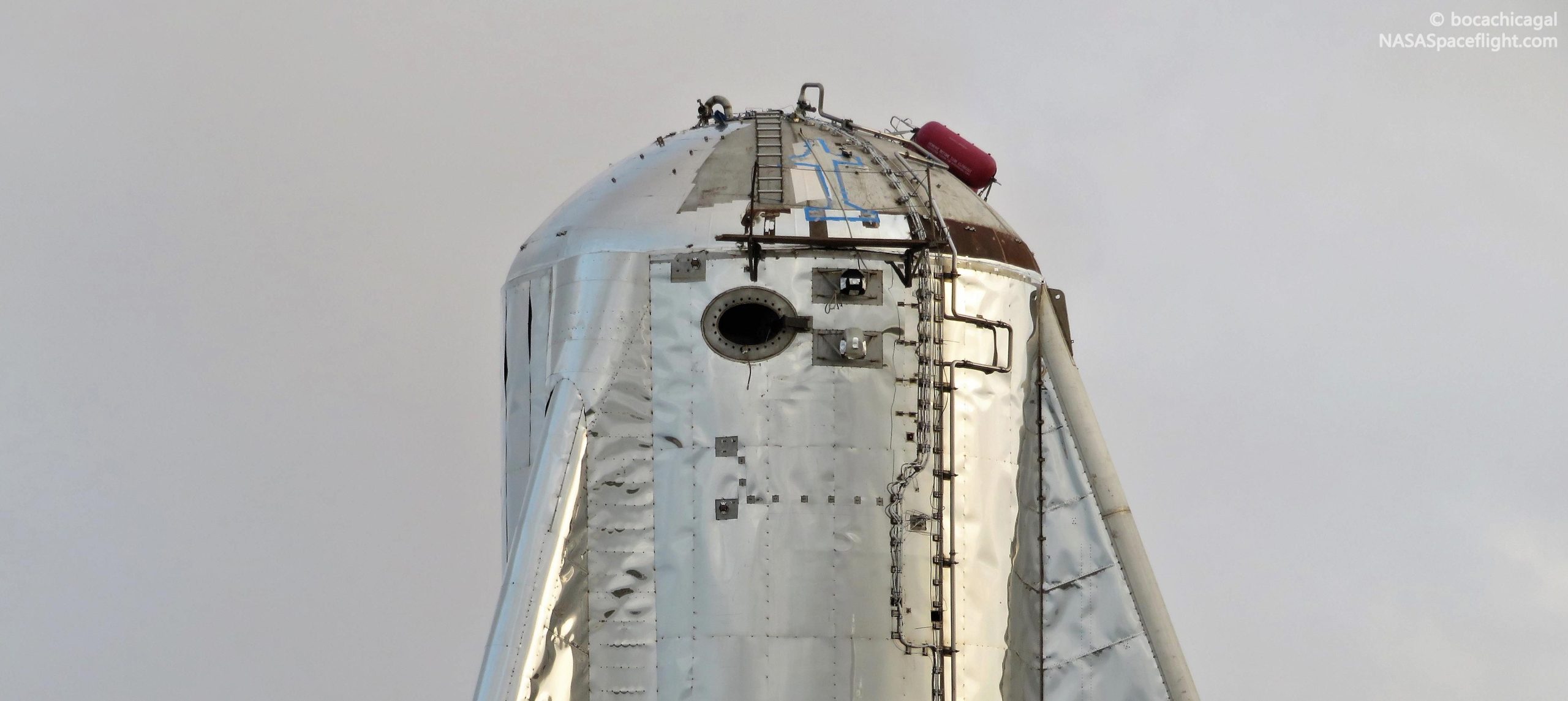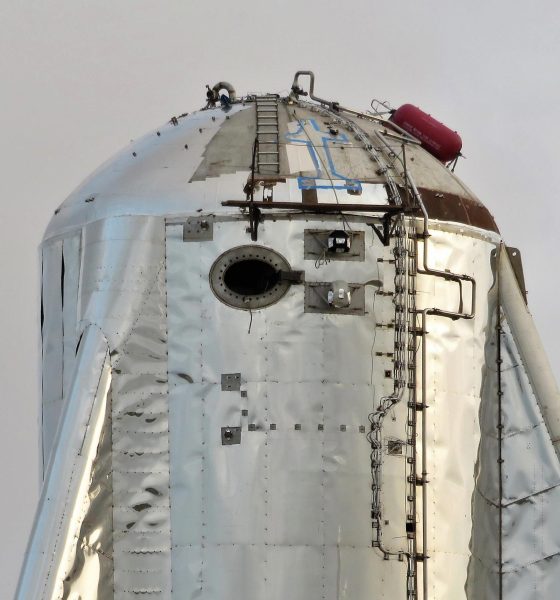

News
SpaceX’s Starhopper gains thruster pods as hop test preparations ramp up
Amid a flurry of new construction at SpaceX’s Boca Chica facilities, technicians have begun to install thruster pods on Starhopper in anticipation of the prototype’s first untethered flights.
According to CEO Elon Musk, Starhopper’s “untethered hover tests” will begin with just one Raptor engine installed, potentially allowing hops to restart within the next few weeks. SpaceX is currently testing Raptor SN03 (and possibly SN02) a few hundred miles north in McGregor, Texas, just a few hours’ drive south once the engine is deemed flight-ready. Meanwhile, Starhopper itself needs a considerable amount of new hardware before it can begin Raptor-powered flight testing.
A Falcon Raptor-powered Starship
Purely from a visible perspective, the most important component Starhopper is missing is a way to control its attitude and remain stable while under Raptor power, particularly critical for hovering. Enter the aptly-named attitude control system (ACS), essentially a pod of omnidirectional thrusters. SpaceX already happens to have its own extremely mature ACS proven over nearly two dozen successful Falcon 9 and Heavy booster landings, as well as every Falcon upper stage that has ever flown. SpaceX’s ACS is based on powerful nitrogen gas thrusters, known for their white puffs during Falcon 9 booster recovery and landing operations.
On May 6th and 7th, SpaceX began to install what looked like Falcon ACS pods on Starhopper. Curiously, of the two pairs of thrusters now installed, half appear to be taken directly off of older mothballed Falcon 9 boosters, while the other two seem to have been acquired from a Falcon 9 Block 5 rocket. The latter pods may very well have come from Falcon 9 B1050, the booster that unintentionally landed in the Atlantic Ocean last December.
Based on the asymmetric location of the first two pod groups, Starhopper’s ACS will probably use a tripod layout. Additionally, the reason for the thruster pairs – versus Falcon 9’s single pods – is likely simple: Starhopper is far heavier than a Falcon booster. To get the same level of control authority, SpaceX is thus pairing pods together to double the functional strength of Starhopper’s ACS.
This leads smoothly to the installation of two (likely soon to be three) new composite-overwrapped pressure vessels (COPVs). Starhopper already has two COPVs installed on the outside of its upper tank dome, now effectively confirmed to be helium containers needed to pressurize the vehicle’s methane and oxygen tanks. Based on the fact that Starhopper’s new ACS pods appear to have come straight from Falcon boosters, it’s safe to say that the 2 (or 3) new COPVs will supply the hopper’s thrusters with gaseous nitrogen.

The Ugly Starshipling
In general, this is just the latest chapter in the book of the oddity that is Starhopper. With helium tank pressurization and nitrogen ACS thrusters taken straight from Falcon 9, a major facet of SpaceX’s Mars architecture is entirely missing from the prototype. Known as autogenous pressurization, BFR was meant to use gasified versions of its onboard liquid oxygen and methane to pressurize its propellant tanks. In a similar vein, BFR was expected to integrated the same propellant into its ACS. Simply put, helium is simply out of the question if SpaceX wants to realize its reusable Mars transport architecture. Mars does have a minute quantity of nitrogen available in its already very thin atmosphere, but extracting hundreds or thousands of kilograms is impractical in the near-term, particularly if the first Starship have to carry all of their extraction equipment from Earth.
Although Musk has seemingly confirmed that Starship and Super Heavy will use ACS thrusters more akin to the Falcon family’s cold nitrogen gas pods, he did also confirm that autogenous pressurization would be a part of even the earliest iterations of the rocket. The move from carbon fiber to steel tanks likely made a major difference, as carbon composites have extremely limited heat resistance.
Without autogenous pressurization and propellant tanks closer to the thickness of orbit-capable Starships, Starhopper is really more of a mobile test stand for Raptor than anything else. The ungainly vehicle also offers SpaceX engineers an opportunity to test Starship/Super Heavy avionics in flight conditions, particularly with respect to controlling a real Raptor engine on the fly.

Check out Teslarati’s Marketplace! We offer Tesla accessories, including for the Tesla Cybertruck and Tesla Model 3.

News
Tesla FSD fleet is nearing 7 billion total miles, including 2.5 billion city miles
As can be seen on Tesla’s official FSD webpage, vehicles equipped with the system have now navigated over 6.99 billion miles.

Tesla’s Full Self-Driving (Supervised) fleet is closing in on almost 7 billion total miles driven, as per data posted by the company on its official FSD webpage.
These figures hint at the massive scale of data fueling Tesla’s rapid FSD improvements, which have been quite notable as of late.
FSD mileage milestones
As can be seen on Tesla’s official FSD webpage, vehicles equipped with the system have now navigated over 6.99 billion miles. Tesla owner and avid FSD tester Whole Mars Catalog also shared a screenshot indicating that from the nearly 7 billion miles traveled by the FSD fleet, more than 2.5 billion miles were driven inside cities.
City miles are particularly valuable for complex urban scenarios like unprotected turns, pedestrian interactions, and traffic lights. This is also the difference-maker for FSD, as only complex solutions, such as Waymo’s self-driving taxis, operate similarly on inner-city streets. And even then, incidents such as the San Francisco blackouts have proven challenging for sensor-rich vehicles like Waymos.
Tesla’s data edge
Tesla has a number of advantages in the autonomous vehicle sector, one of which is the size of its fleet and the number of vehicles training FSD on real-world roads. Tesla’s nearly 7 billion FSD miles then allow the company to roll out updates that make its vehicles behave like they are being driven by experienced drivers, even if they are operating on their own.
So notable are Tesla’s improvements to FSD that NVIDIA Director of Robotics Jim Fan, after experiencing FSD v14, noted that the system is the first AI that passes what he described as a “Physical Turing Test.”
“Despite knowing exactly how robot learning works, I still find it magical watching the steering wheel turn by itself. First it feels surreal, next it becomes routine. Then, like the smartphone, taking it away actively hurts. This is how humanity gets rewired and glued to god-like technologies,” Fan wrote in a post on X.
News
Tesla starts showing how FSD will change lives in Europe
Local officials tested the system on narrow country roads and were impressed by FSD’s smooth, human-like driving, with some calling the service a game-changer for everyday life in areas that are far from urban centers.

Tesla has launched Europe’s first public shuttle service using Full Self-Driving (Supervised) in the rural Eifelkreis Bitburg-Prüm region of Germany, demonstrating how the technology can restore independence and mobility for people who struggle with limited transport options.
Local officials tested the system on narrow country roads and were impressed by FSD’s smooth, human-like driving, with some calling the service a game-changer for everyday life in areas that are far from urban centers.
Officials see real impact on rural residents
Arzfeld Mayor Johannes Kuhl and District Administrator Andreas Kruppert personally tested the Tesla shuttle service. This allowed them to see just how well FSD navigated winding lanes and rural roads confidently. Kruppert said, “Autonomous driving sounds like science fiction to many, but we simply see here that it works totally well in rural regions too.” Kuhl, for his part, also noted that FSD “feels like a very experienced driver.”
The pilot complements the area’s “Citizen Bus” program, which provides on-demand rides for elderly residents who can no longer drive themselves. Tesla Europe shared a video of a demonstration of the service, highlighting how FSD gives people their freedom back, even in places where public transport is not as prevalent.
What the Ministry for Economic Affairs and Transport says
Rhineland-Palatinate’s Minister Daniela Schmitt supported the project, praising the collaboration that made this “first of its kind in Europe” possible. As per the ministry, the rural rollout for the service shows FSD’s potential beyond major cities, and it delivers tangible benefits like grocery runs, doctor visits, and social connections for isolated residents.
“Reliable and flexible mobility is especially vital in rural areas. With the launch of a shuttle service using self-driving vehicles (FSD supervised) by Tesla in the Eifelkreis Bitburg-Prüm, an innovative pilot project is now getting underway that complements local community bus services. It is the first project of its kind in Europe.
“The result is a real gain for rural mobility: greater accessibility, more flexibility and tangible benefits for everyday life. A strong signal for innovation, cooperation and future-oriented mobility beyond urban centers,” the ministry wrote in a LinkedIn post.
News
Tesla China quietly posts Robotaxi-related job listing
Tesla China is currently seeking a Low Voltage Electrical Engineer to work on circuit board design for the company’s autonomous vehicles.

Tesla has posted a new job listing in Shanghai explicitly tied to its Robotaxi program, fueling speculation that the company is preparing to launch its dedicated autonomous ride-hailing service in China.
As noted in the listing, Tesla China is currently seeking a Low Voltage Electrical Engineer to work on circuit board design for the company’s autonomous vehicles.
Robotaxi-specific role
The listing, which was shared on social media platform X by industry watcher @tslaming, suggested that Tesla China is looking to fill the role urgently. The job listing itself specifically mentions that the person hired for the role will be working on the Low Voltage Hardware team, which would design the circuit boards that would serve as the nervous system of the Robotaxi.
Key tasks for the role, as indicated in the job listing, include collaboration with PCB layout, firmware, mechanical, program management, and validation teams, among other responsibilities. The role is based in Shanghai.
China Robotaxi launch
China represents a massive potential market for robotaxis, with its dense urban centers and supportive policies in select cities. Tesla has limited permission to roll out FSD in the country, though despite this, its vehicles have been hailed as among the best in the market when it comes to autonomous features. So far, at least, it appears that China supports Tesla’s FSD and Robotaxi rollout.
This was hinted at in November, when Tesla brought the Cybercab to the 8th China International Import Expo (CIIE) in Shanghai, marking the first time that the autonomous two-seater was brought to the Asia-Pacific region. The vehicle, despite not having a release date in China, received a significant amount of interest among the event’s attendees.











